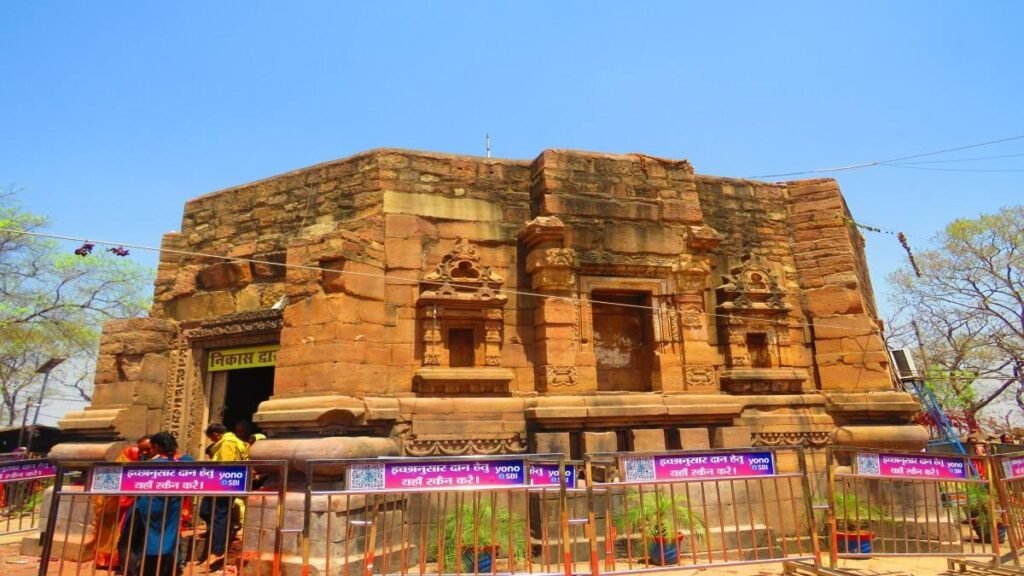India is home to thousands of spectacular temples, but one stands above the rest in age, mystery, and uninterrupted worship: the Mundeshwari Devi Temple in Bihar, recognised as the oldest functional temple in the country.
Location, Route, and How to Reach
Finding the Mundeshwari Devi Temple is part of the pilgrimage’s adventure:
- Where: Ramgarh Village, Mundeshwari Hills, Kaimur Plateau, Bihar.
- By Air: Lal Bahadur Shastri International Airport, Varanasi (102 km away).
- By Train: The Nearest railway station is Mohania (Bhabua Road), located 22 km away.
- By Road: The temple is accessible via Patna, Gaya, and Varanasi, with regular buses and taxis connecting these cities to the temple.
Route and Visitor Information
Travellers often plan their visit to the Mundeshwari Devi Temple as part of a wider tour of Bihar and Eastern India, including stops at other pilgrimage sites in the Kaimur region and nearby states:
- Travel tip: Visiting during festivals offers a unique glimpse into local culture and communal worship, but be prepared for larger crowds.
- Accommodation: Guesthouses and hotels are available in Bhabua and Mohania towns.
- The best time to visit is from October to April, with peak crowds during Navaratra and Shivratri.
Key Details:
| Aspect | Details |
|---|---|
| Location | Mundeshwari Hills, near Ramgarh Village, Kaimur district, Bihar, India |
| Deity | Goddess Mundeshwari (Durga) and Lord Shiva |
| Historical Importance | Considered the oldest functional Hindu temple in the world, dating back to about 108 CE |
| Architecture Style | Nagara style, octagonal plan, stone structure |
| Main Festival | Navaratri Mela (grand annual fair), Ramnavami, Shivratri |
| Other Deities | Ganesha, Surya, Vishnu |
| Opening Hours | 6:00 AM to 7:00 PM (daily) |
| Break Time | 12:00 PM to 12:20 PM (daily) |
| Mangla Aarti | 5:30 AM |
| Madhyan Aarti | 11:30 AM |
| Sandhya Aarti | 6:00 PM |
| Entry Fee | Free |
| VIP Darshan | ₹501 |
| Suggested Visiting Time | October to March (pleasant weather) |
| Distance from Patna | Approx. 200 km, ~4-5 hours by taxi/car |
| Nearest Town | Bhabua (~10 km away) |
| How to Reach | Train to Bhabua Road station (20 km), bus/taxi/auto from there |
| Travel Cost (Patna–Temple) | Train + taxi option: ₹1,100–₹2,700; Taxi: ₹3,400–₹4,900 (one way, depending on vehicle type) |
- For group tours or packaged experiences, the price typically starts around ₹14,999 for 2 days/1 night, including meals, transfers, and sightseeing from Patna or Varanasi.
History and Origins
The Mundeshwari Devi Temple, situated on the Mundeshwari Hills at an elevation of 608 feet above sea level in Bihar’s Kaimur district, claims origins dating back to 108 CE, according to the Archaeological Survey of India (ASI). The temple has witnessed continuous worship and rituals, making it uniquely important in the global Hindu context.
- The Mundeshwari Devi Temple is dedicated to Devi Mundeshwari, a form of Goddess Durga, and Lord Shiva.
- Archaeological finds, including inscriptions and a Brahmi-sealed artefact from Sri Lankan King Dutthagamani (1st century BCE), suggest the temple’s antiquity as a pilgrimage site, attracting worshippers from distant lands even in ancient times.
- Historians debate the exact date of construction, as the existing octagonal stone structure incorporates fragments from earlier shrines, with some elements dating back to the 6th and 7th centuries CE.
Notable Timelines
- 108 CE: Date according to some archaeological evidence.
- 625 CE: Evidence of temple construction and worship during the Gupta era.
- 1790: First portrait of the temple drawn by the Daniel brothers.
- 2003: Discovery of Brahmi script royal seal, further confirming ancient origins.
Culture and Religious Significance
The Mundeshwari Devi Temple is a vital centre for spirituality, culture, and community:
- Worship of Devi Durga here reflects the Tantric traditions prevalent in Eastern India.
- The temple celebrates major festivals like Ramnavami, Shivratri, and especially Navaratri, drawing thousands of devotees every year.
- Rituals have been observed without interruption for nearly two millennia, making it a rare “living temple”.
- The temple is both a Shaivite and Shakta centre, with the four-faced Shiva linga and the idol of Devi Mundeshwari at its heart.
Architecture: An Ancient Marvel
The architectural features distinguish Mundeshwari from every other Indian temple:
- The temple is constructed in an octagonal layout, a rarity in Indian temple design and possibly one of the earliest forms of Nagara style.
- Its interior includes carved niches, vase-and-foliage mouldings, and intricate doorways, while the sanctum houses both the Shiva linga and the powerful ten-armed Durga (Mahishasurmardini).
- Though the main shikhara or tower is lost to time, contemporary renovations and the addition of a new roof have preserved much of the temple’s glory.
- Notable sculptures depict Ganesha, Surya, Vishnu, and various guardians, emphasising the temple’s pluralistic religious ethos.

Tourist Experience: Things to See and Do
Visiting the temple gives more than religious fulfilment; it’s an experience woven into the landscape, culture, and heritage of Bihar:
- Participate in annual fairs during Navaratri, which attract thousands and offer a lively showcase of local arts, crafts, and foods.
- Explore nearby historic sites, including the Murugan Temple (Saluvankuppam), Chandika Sthan, Mangala Devi Kannagi Temple, and Maa Jaleshwari Temple.
- Witness the panoramic view from Mundeshwari Hills, and soak in the tranquil surroundings of the Kaimur plateau.
- Marvel at ancient inscriptions, fragments of sculptures, and unique stone vessels found around the temple complex.
Economic and Social Impact
Temples in India play pivotal roles in their local economies, and Mundeshwari is no exception:
- Regular fairs attract large crowds, which in turn boost local businesses and vendors.
- The temple has received government support for renovation, tourism infrastructure, and public amenities, including solar-powered lighting and better access roads.
- Bihar state has allocated over Rs 2 crore to improve the visitor experience. Compared to other temples in India, Mundeshwari is less about monetary wealth and more about cultural legacy.
Temple Revenue: Context among Indian Temples
While Mundeshwari doesn’t compete with temples like Tirupati, Padmanabhaswamy, or Siddhivinayak in terms of raw revenue, its true treasure lies in uninterrupted devotion, academic interest, and tourism:
- South Indian temples are renowned for their vast wealth and donations, but Mundeshwari remains a focal point for cultural preservation and education.
- Its status as the oldest functional temple augments tourism revenue for the state of Bihar and supports regional heritage initiatives.
FAQs About the Oldest Temple in India
What is the oldest temple in India?
The Mundeshwari Devi Temple in Bihar is widely recognised as the oldest functional temple in India, dating back to 108 CE.
Which deities are worshipped at the Mundeshwari Temple?
The temple is dedicated to Devi Mundeshwari (Durga) and Lord Shiva, with additional idols of Ganesha, Surya, and Vishnu.
What makes the Mundeshwari Devi temple unique?
Its continuous worship, octagonal architecture, and ancient inscriptions set it apart from other Indian temples, earning it global renown.
How can tourists reach the temple?
The temple is accessible by air (nearest airport: Varanasi), rail (Mohania station), and road via Patna, Gaya, or Varanasi.
What is the economic significance of the temple?
While not as wealthy as southern temples like Padmanabhaswamy or Tirupati, Mundeshwari’s primary value is its cultural, spiritual, and historical impact on the region.
Which festivals are major attractions?
Navaratri, Ramnavami, and Shivratri are celebrated annually, drawing thousands of devotees and tourists.
Are there any restoration projects underway?
The Archaeological Survey of India, in collaboration with the Bihar government, is undertaking ongoing renovation projects to preserve the temple’s architecture and improve visitor facilities.
